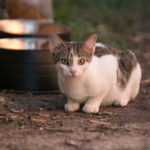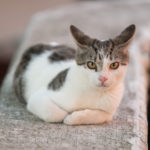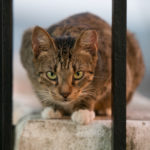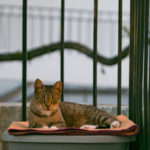In the sunny courtyards surrounding Agnes Arnold Hall, a population of “little coogs,” feral cats, lounge among busy University of Houston students, eating from bowls placed near the bus stop and napping on the concrete ledges flanking the building.
Psychology junior Aleah Johnson has cared for the cats from a distance since she arrived at UH in 2017, and her efforts have been a labor of love since the beginning.
“Community and feral cats hold a spot close to my heart because I want to take them all home and love them even though I can’t,” Johnson said.
Although at first glance the cats might be ‘purrceived’ as cuddly, furry friends, the cats have lived free of close human interaction their whole lives.
“Usually community and feral cats can’t be adopted because they aren’t suited for domestic life,” Johnson said.
Community cats, also known as feral cats, live outdoors and do not have owners. These cats may get by on their own, hunting small animals for food, or they may have their diets supplemented by people in the community.
“Whatever a cat’s individual circumstances, the term ‘community cat’ reflects the reality that for these cats, ‘home’ is within the community rather than in an individual household,” Houston animal shelter BARC said on its website.
According to BARC, it was widely accepted in the past to attempt to handle populations of community cats by way of catch-and-kill. This leaves former sites of cat colonies open to a “vacuum effect” in which new cats from nearby areas flood in to take advantage of shelter and feeding opportunities.
According to ASPCA’s website, attempting eradication of cat colonies is an ineffective method to control community cat populations.
The best solution, according to ASPCA and BARC, is a method known as trap, neuter and return (TNR). TNR programs enable community members to capture cats without an owner and bring them to a shelter where the cat can receive a rabies vaccination and a spay or neuter procedure before being returned to its colony.
“If more animals are responsibly released back into their original environments through the TNR program, less animals are euthanized,” BARC said on its website explaining how the program works.
Johnson has taken action to help the UH community cats through spaying and neutering, as well as providing them with food.
“I have taken two to get fixed and vaccinated, and luckily they were still young enough to be socialized and adopted out,” Johnson said.
There are at least four cats living near Agnes Arnold, Johnson said. According to BARC, a colony can range from three to 25 cats.
“The population fluctuates over time with some cats leaving or joining, and there is always a big rise during summer and spring months during kitten season. Some cats don’t actually leave campus. They just migrate around,” Johnson said.
news@thedailycougar.com
—
“Student cares for beloved feral campus cats” was originally posted on The Daily Cougar




